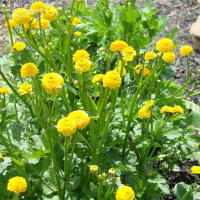Giant Buttercup
Ranunculus acris
Key characteristics
Perennial, reaching up to 1 m tall
Yellow glossy flowers 15 – 25 mm across with 5 petals appear mainly between November and April
A short rhizome (horizontal underground stem up to about 100 mm long) with fibrous remains of old leaves, axillary buds and fleshy roots
Leaves large (as big as your outstretched hand), hairy, divided into 3-7 lobes, on long hairy stems
Avoided by dairy cattle due to bitter taste
Common in swamp and wasteland areas, river flats and dairy pastures in high-rainfall areas.
Life cycle
Giant buttercup is a short-lived rhizomatous perennial, with individual plants flowering and producing seeds and daughter rhizomes for several years before dying
Seeds germinate from late autumn (May) to late spring (November)
Leaf growth peaks in late spring
Leafy daughter shoots are produced throughout summer and autumn as branches on the parent plant’s rhizomes, resulting in a slow outward creep of the plant and the creation of patches
Flowering stems die back after the seeds are shed and are replaced by the daughter shoots which overwinter as leafy rosettes
Seeds fall close to the parent plant and remain dormant for several years in the soil
The seeds each have a small hook enabling them to attach to, and be readily spread long distances by grazing cattle and other animals
Other long-distance seed dispersal vectors include hay, farming equipment, roadside mowers, footwear, clothes and flood waters.










Plant Protection Products
- N/A
- N/A
- N/A
- N/A
- N/A
- N/A
- N/A
- N/A
- N/A